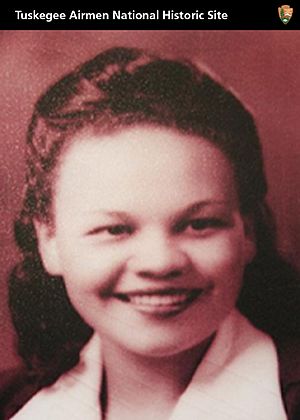Mildred Hemmons Carter facts for kids
Quick facts for kids
Mildred Hemmons Carter
|
|
|---|---|
 |
|
| Born | September 14, 1921 |
| Died | October 21, 2011 (aged 90) |
| Known for | Designated Original Tuskegee Airman |
| Spouse(s) | Herbert Carter (married 1942-2011) |
Mildred Louise Hemmons Carter (1921-2011) was a brave and pioneering pilot. She was one of the first women to get a pilot's license through a special training program. This made her the first black female pilot in Alabama. Even though she faced challenges, she later became an official member of both the famous Tuskegee Airmen and the Women Airforce Service Pilots.
Contents
Early Life and Education
Mildred Louise Hemmons was born on September 14, 1921. Her parents were Mamie and Luther Hemmons. Her mother worked as the town's postmaster. Her father was in charge of a sawmill.
Mildred was born in Benson, Alabama. She lived in Tuskegee for a while. Later, her family moved to Enfield, North Carolina. There, her father managed a college for black students.
When the Great Depression caused the school to close, her family moved again. They settled in Holly Springs, Mississippi. Mildred finished high school in Holly Springs when she was just fifteen years old.
College and Pilot Training
After high school, Mildred's family returned to Tuskegee. She enrolled at Tuskegee University. She chose to study business.
Mildred worked in an office that handled applications. These applications were for Tuskegee University's Civilian Pilot Training Program (CPTP). This program helped train new pilots. Mildred wanted to join the program herself.
She applied but was first told no because she was not yet eighteen. The next year, she applied again. This time, she was accepted into the program.
Mildred was part of Tuskegee's very first class of CPTP trainees. On February 1, 1941, she earned her private pilot's certificate. This made her the first black female pilot in Alabama. She often flew a Piper J-3 Cub plane. She rented it from the school.
A month after getting her certificate, Mildred met First Lady Eleanor Roosevelt. Mrs. Roosevelt visited Tuskegee to show support for its pilots. Mildred remembered that "Mrs. Roosevelt was very gracious." She also said, "I was tongue tied."
Marriage and Flying Career
Meeting Herbert Carter
Mildred first met Herbert Carter in 1939. They met on the Tuskegee campus. Herbert later said he was instantly drawn to her. But he was too shy to ask her out.
He finally asked her to a campus dance. He learned that she, like him, was in the CPTP. Herbert was a cadet with the Tuskegee Airmen. During his training, he could not leave the air base. He also could not date other Tuskegee students.
On weekends, he found a way to see Mildred. He would arrange to take a plane for "maintenance flight checks." He would meet Mildred, flying her rented plane, over Lake Martin. The couple would wave and blow kisses as they flew past each other.
After Herbert finished his training, they got married. The wedding was on August 21, 1942. It took place at the Tuskegee Army Airfield chapel.
Joining the Civil Air Patrol
Mildred often flew with C. Alfred "Chief" Anderson. He was Tuskegee's main flight instructor. He believed in her dreams and thought she was one of his best students.
In 1942, Mildred and Anderson went to Montgomery, Alabama. They wanted to join the Civil Air Patrol. Mildred became the first black woman in the Montgomery Civil Air Patrol Squadron. However, because of their race, neither Mildred nor Anderson were ever called to patrol for the state.
Facing Challenges as a Woman Pilot
Because she was a woman, Mildred could not get more advanced training. This was through Tuskegee's Civilian Pilot Training Program. Instead, she applied to the Women Airforce Service Pilots (WASP). By this time, she had flown for more than 100 hours.
Even with her experience, she was rejected. Mildred destroyed her rejection letter. But she said it came directly from Jackie Cochran. The letter stated that she was "not eligible because of my race." Mildred said, "It left no doubt."
Working at Moton Field
During World War II, Mildred worked at Moton Field. This was the only main flight place for African-American pilot candidates. It was part of the United States Air Force.
She was the Chief Clerk of the Quartermaster Corps. Besides office work, she also fixed parachutes. She even operated a bulldozer to clear airstrips.
Life After the War
After the war, Herbert's military career took the Carters to many places. They lived across the United States and in Europe. Eventually, they returned to Tuskegee. They had three children.
Mildred Carter helped and encouraged younger black women. She wanted them to become pilots. Some of the women she mentored became flight nurses. Others became aerospace engineers.
Roosevelt Lewis Jr. was an airfield manager. He was also trained by Charles Anderson. He said that "Mildred is really recognized here in Tuskegee as one of the Tuskegee Airmen."
Mildred and Anderson kept flying together into the 1980s. In 1985, when Mildred was 64, she had to stop flying. This was because she broke her hip.
In February 2011, Mildred was officially recognized. She was declared a member of the Women Airforce Service Pilots. She was also named a Designated Original Tuskegee Airman.
Mildred Carter passed away after a long illness on October 21, 2011.
Images for kids


